Former Deputy Director General, United Nations.
It has been five years since the author published TEERA: A Life of Hope and Fulfilment. The riveting autobiography with a gripping narrative of the terrifying journey of her life in her homeland records how she went from one challenging situation to another, each one being more taxing than the one before. It all led her to a life of being at the mercy of a group of nuns, who sheltered her from the danger that was pursuing her, while her children were forced to depend on relatives to care for them. Now she is ready to bring you a sequel narrating her enriching and eventful life since she arrived in the United States and was reunited with her children.
In part two, she recounts her life since fortunes changed, and her long-lost brother sponsored her to immigrate to the United States, and her children who were living with relatives in three different continents, finally joined her. Though the memories of the past never ceased to haunt her, she gradually built a life of contentment, and a slew of rich experiences came her way that is vividly related to us in part two, Perhaps, the most engaging experience of all was the narrating her own fascinating but tragic story that found its way to the bestseller list of Amazon Prime.
Part three of this sequel is the heart of the book and the reason why the reader will find this book to be both enthralling and educational. In this important section, she chronicles her intimate interactions over time with fifteen individuals, who are at home on the street, embracing the hidden culture of homelessness. In this extraordinary part of the book, she has created a moving portrait of a troubled people, in a desperate world few ever see.
They reveal the formidable struggles they face every day, from catastrophic health issues to routine threats of physical and sexual assault. But they also speak about their own intellectual interests and spiritual lives, Illuminating the rich and complicated humanity that surrounds them, which challenges stereotypes about homeless people and provides jarring, unforgettable insights into an exponentially increasing section of society.
She has brought forth her profound experiences with those she introduces to us and presents them with great care and elegant craftsmanship in her own unique style.
What emerges from the stories retold to us by Teera is that it is the result of systemic or societal barriers, a lack of affordable and appropriate housing, the individual’s household’s financial, mental, cognitive, behavioral, or physical challenges, or racism and discrimination. Most people do not choose to be homeless, and the experience is generally negative, unpleasant, stressful, and distressing. Teera delves into these complex realities of homelessness to paint a gripping picture of individuals living on the street and their daily survival strategies.
Most of all, what they crave is for someone to listen to their stories, and Teera was a ready and patient listener. Listen she did, by person and by phone for hours on end. In many ways, a homeless individual becomes a bystander as his routine takes over his rational thinking, and the burden of finding a solution belongs to those who care for the person concerned. Teera was there in many situations to provide advice and assistance when she saw anyone who needed help or came to her.
Giving the rationale for her narration here, she writes, “There was nothing strange about the homeless strangers that crossed my path unexpectedly. These encounters compel me to write and share in the hope of making a positive difference in the world of homeless”.
The narrative of her experiences and that of those she introduces to us in this brilliant, heartbreaking section of the book makes it a part of contemporary history and well worth a read.
The book is written by an author, a profile in courage, whose immense empathy, through her own heartrending experience, is attuned to the intricacies of the physical and emotional damage left behind in the wake of human suffering. The author’s own experiences, and that of diverse people she met, are presented to us, capturing their highlights, tears and heartwarming smiles on a canvas in a way that both teaches and entertains us.
I wish to thank Teera for giving me the opportunity of editing her illuminating script. I am grateful to Aditha Dissanayake, award-winning Author Journalist, for as always, reading my work and offering perceptive comments. I must pay my compliments to Manjula Kumara Gamage for his outstanding work in designing the attractive cover and formatting the text for publication. Finally, I wish to express my appreciation to my friend Judith Larsen, the Attorney author, for taking the time to read the text and assuring that it is worthy of publication.
Nandasiri (Nandi) Jasentuliyana
Former Deputy Director General, United Nations.












![TV-Poster-All-Exhibition-Sri-Lanka-in-Focus-USA-2025[1]](https://www.srilankafoundation.org/wp-content/uploads/2025/04/TV-Poster-All-Exhibition-Sri-Lanka-in-Focus-USA-20251-450x450.jpg)









